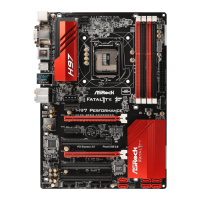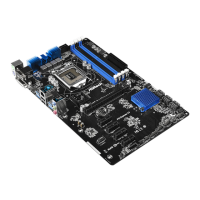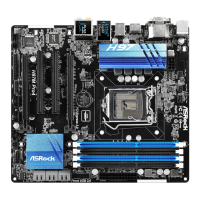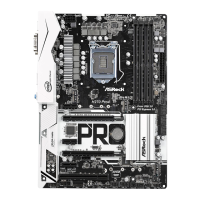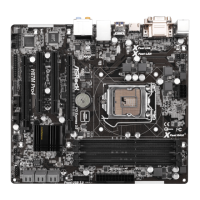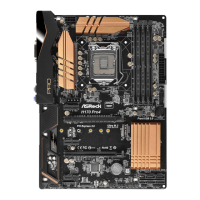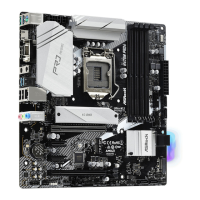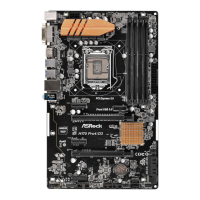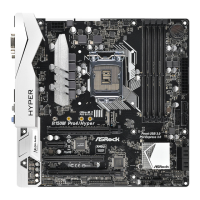
Do you have a question about the ASROCK H97 Pro4 and is the answer not in the manual?
| ECC | No |
|---|---|
| Non-ECC | Yes |
| Memory channels | Dual-channel |
| Memory slots type | DIMM |
| Number of memory slots | 4 |
| Supported memory types | DDR3-SDRAM |
| Maximum internal memory | 32 GB |
| Supported memory clock speeds | 1066, 1333, 1600 MHz |
| Processor socket | LGA 1150 (Socket H3) |
| Processor manufacturer | Intel |
| Compatible processor series | Intel Celeron, Intel Pentium |
| Intel® Core i3/i5/i7/i9 series | i3-4xxx, i5-4xxx, i7-4xxx |
| Maximum number of SMP processors | 1 |
| USB 2.0 connectors | 2 |
| Number of SATA III connectors | 6 |
| Number of Parallel ATA connectors | 0 |
| RAID levels | 0, 1, 5, 10 |
| Supported storage drive interfaces | SATA III |
| USB 2.0 ports quantity | USB 2.0 ports have a data transmission speed of 480 Mbps, and are backwards compatible with USB 1.1 ports. You can connect all kinds of peripheral devices to them. |
| Ethernet interface type | Gigabit Ethernet |
| Audio chip | Realtek ALC892 |
| Cooling type | Passive |
| Certification | FCC, CE, WHQL, ErP/EuP |
| Component for | PC |
| Motherboard chipset | Intel® H97 |
| PC health monitoring | CPU, FAN, Power supply, Temperature |
| Audio output channels | 7.1 channels |
| Motherboard form factor | ATX |
| Graphics card | HD Graphics 4000 |
| DirectX version | 11.1 |
| Maximum resolution | 1920 x 1200 pixels |
| Maximum graphics card memory | 1792 MB |
| Parallel processing technology support | Not supported |
| BIOS type | EFI AMI |
| ACPI version | 1.1 |
| BIOS memory size | 16 Mbit |
| Cables included | SATA |
| Width | - mm |
|---|
Lists all items included in the motherboard package.
Provides detailed technical specifications of the motherboard's hardware components.
Visual diagram identifying and labeling major motherboard components.
Details the rear panel connectors and their functions.
Essential safety and handling guidelines before installing hardware components.
Step-by-step instructions for correctly installing the CPU into its socket.
Guide for mounting the CPU cooler, including thermal paste application.
Procedures for inserting RAM modules and understanding dual-channel configuration.
Explains the types and usage of PCI and PCIe expansion slots.
Describes the function and configuration of system jumpers on the motherboard.
Identifies and explains the purpose of internal headers and connectors.
How to install necessary drivers and utilities from the provided support CD.
Guide to ASRock's A-Tuning software for system monitoring and control.
Setup and usage of Intel's feature for faster system resume from sleep.
Setup and usage of Intel's feature for background updates during sleep.
Overview of the ASRock APP Shop for downloading software and apps.
Instructions for finding, downloading, and installing apps from the APP Shop.
Process for updating BIOS and drivers through the ASRock APP Shop.
Configuration options available within the ASRock APP Shop settings.
Guide for installing and customizing the Start8 Windows Menu utility.
Explains how to enter and navigate the UEFI BIOS setup utility.
Describes the main menu options available in the UEFI interface.
Lists and explains the keyboard controls for UEFI navigation.
Overview of the system information displayed on the UEFI Main screen.
Detailed settings for overclocking CPU, memory, and other system parameters.
Introduction to the various advanced configuration categories within UEFI.
Settings for CPU features, core control, and power management technologies.
Configuration options related to the motherboard's chipset and integrated peripherals.
Settings for SATA controllers, drive modes (IDE, AHCI, RAID), and power management.
UEFI settings for configuring Intel's Rapid Start Technology.
UEFI settings for configuring Intel's Smart Connect Technology.
Configuration for Super I/O ports like PS/2 and serial ports.
Settings for Advanced Configuration and Power Interface power management.
Options for enabling/disabling USB controllers and managing compatibility.
Configuration for hardware-based security features like TPM.
Access to various diagnostic and utility tools within the UEFI setup.
Displays real-time system hardware status (temp, voltage, fan speed).
Configuration of boot order, fast boot options, and CSM settings.
Settings for system passwords, secure boot, and user access control.
Options to save, discard, or load UEFI settings and exit the utility.
